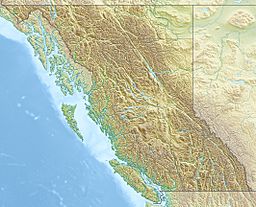Atlin Volcanic Field facts for kids
Quick facts for kids Atlin Volcanic Field |
|
|---|---|
| Highest point | |
| Elevation | 1,880 m (6,170 ft) |
| Geography | |
| Location | British Columbia, Canada |
| Parent range | Teslin Plateau (southern Yukon Plateau) |
| Geology | |
| Age of rock | Holocene |
| Mountain type | Cinder cones |
| Volcanic arc/belt | Northern Cordilleran Volcanic Province |
| Last eruption | Unknown, possible eruptions in 1898. |
The Atlin Volcanic Field is a group of small volcanoes in British Columbia, Canada. It is also known as the Llangorse Volcanic Field or the Surprise Lake Volcanic Field. These volcanoes are mostly cinder cones, which are cone-shaped hills made of volcanic rock pieces. They formed during the late Pleistocene (the last ice age) and Holocene (our current time) periods. This volcanic field is located on the Teslin Plateau, east of Atlin Lake.
The largest volcano here is Ruby Mountain, which stands 1,880 meters (about 6,168 feet) tall. Ice from past ice ages has partly shaped this mountain. Two other volcanoes, Cracker Creek Cone and Volcanic Creek Cone, are found in U-shaped valleys carved by glaciers. These two might have formed after the last ice age ended.
Contents
The 1898 Eruption Mystery
In 1898, a newspaper in the Yukon reported something exciting. It said that a volcano was erupting near Atlin, about 80 kilometers (50 miles) south of Gladys Lake.
Miners and the Glowing Mountain
The newspaper article claimed that miners working in the area could see a bright glow. This glow was so strong that they could work even during the dark nights. The report also mentioned that a group of people were going to investigate the eruption. However, no further reports about this eruption were ever made.
Was There Really an Eruption?
Scientists have studied the area since then. Several recent studies, including one by the Geological Survey of Canada, looked into the 1898 report. They found that Ruby Mountain was definitely not the site of a historic eruption. The Cracker Creek and Volcanic Creek cones also showed no signs of erupting at that time.
A Possible Explanation
So, what could have caused the newspaper story? One idea is that miners found gold under an old lava flow at the base of Ruby Mountain. They were digging tunnels under this old lava to get the gold. Ruby Mountain gets its name because it looks reddish. This color comes from the reddish volcanic rock (called scoria) that covers much of its top.
Imagine miners working in the summer. The sun would shine off the reddish sides of the mountain. This bright, reddish glow might have looked like an eruption from far away. It's easy to see how such a rumor could have started. Today, there is no real proof that an eruption happened in the region in 1898. The old report is considered uncertain.
Volcanoes in the Field
The Atlin Volcanic Field includes several volcanoes. Some of the main ones are:


